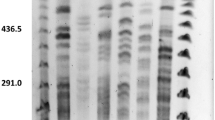Abstract
A total of 50Clostridium butyricum strains from clinical and nonclinical sources and 14C. beijerinckii strains originating from dairy products were analyzed for their plasmid content, antibiotic resistance, and bacteriocinogenic activity. The incidence of antibiotic resistance and presence of plasmidic DNA was more widespred among theC. butyricum strains from clinical source than among theC. beijerinckii strains, all of the originating from dairy products. In many of theC. butyricum strains, a small plasmid of 4.5 megadaltons was encountered. No relation was found between the plasmid pattern, the antibiotic resistance, the geographic localization of the isolates, or the clinical condition of the patients.
Similar content being viewed by others
Literature Cited
Bergere JL, Gouet P, Hermier J, Mocquot G (1968) LesClostridium du groupe butyrique dans les produits laitiers. Ann Inst Pasteur de Lille 19:41–54
Blaschek HP, Solberg M (1981) Isolation of a plasmid responsible for caseinase activity inClostridium perfringens ATCC3626B. J Bacteriol 147:262–266
Brefort G, Magot M, Ionesco H, Sebald M (1977) Characterization and transferability ofClostridium perfringens plasmids. Plasmid 1:52–66
Casse F, Boucher C, Julliot JS, Michel M, Denarie J (1979) Indentification and characterization of large plasmids inRhizobium meliloti using agarose gel electrophoresis. J Gen Microbiol 113:229–242
Cummins CS, Johnson JL (1971) Taxonomy of the clostridia: wall composition and DNA homologies inClostridium butyricum and other butyric acid-producing Clostridia. J Gen Microbiol 67:33–46
Duncan CL, Rokos EA, Christenson CM, Rood JI (1978) Multiple plasmids in different toxigenic types ofClostridium perfringens: possible control of beta toxin production. In: Schlessinger D (ed) Microbiology. Washington DC: American Society for Microbiology, pp 246–248
Howard FM, Bradley JM, Flynn DM, Noone P, Szawatkowski M (1977) Outbreak of necrotizing enterocolitis caused byClostridium butyricum. Lancet 2:1099–1102
Ionesco H, Bieth G, Dauguet C, Bouanchaud D (1976) Isolement et identification de deux plasmides d'une souche bacteriocinogène deClostridium perfringens. Ann Microbiol [B] 127:283–294
Laird WJ, Aaronson W, Silver RP, Habig WH, Hardegree MC (1980) Plasmid associated toxigenicity inClostridium tetani. J Infect Dis 142:623–624
Li AW, Krell PJ, Mahony DE (1980) Plasmid detection in a bacteriocinogenic strain ofClostridium perfringens. Can J Microbiol 26:1018–1022
Magot M (1981) Some properties of theClostridium butyricum group β-lactamase. J Gen Microbiol 127:113–119
Magot M (1981) Résistance aux pénicillines dûe à la production d'une béta-lactamase chez lesClostridium du groupebutyricum. CR Acad Sci [III] 292:285–287
Magot M (1984) L'antibiogramme des bactéries du genreClostridium. Ann Microbiol [A] 135:443–456
Magot M, Carlier JP, Popoff MR (1983) Identification ofClostridium butyricum andClostridium beijerinckii by gasliquid chromatography and sugar fermentation: correlation with DNA homologies and electrophoretic patterns. J Gen Microbiol 129:2837–2845
Meyers JA, Sanchez D, Elwell LP, Falkow S (1979) Simple agarose gel electrophoresis method for identification and characterization of plasmid deoxyribonucleic acid. J Bacteriol 127:1529–1537
Mihelc VA, Duncan CL, Chambliss GH (1978) Characterization of a bacteriocinogenic plasmid inClostridium perfringens CW55. Antimicrob Agents Chemother 14:771–779
Minton N, Morris JG (1981) Isolation and partial characterization of three cryptic plasmids from strains ofClostridium butyricum. J Gen Microbiol 127:325–331
Muldrow LL, Archibold ER, Nunez-Montiel OL, Sheehy RJ (1982) Survey of the extrachromosomal gene pool ofClostridium difficile. J Clin Microbiol 16:637–640
Pan Hou HSK, Hosono M, Imura N (1980) Plasmid controlled mercury biotransformation byClostridium cochlearium T-2. Appl Environ Microbiol 40:1007–1011
Popoff MR, Sebald M (1981) Mise en évidence chezClostridium butyricum d'un facteur thermostable responsable du pouvoir pathogène expérimental. CR Acad Sci [III] 292:763–766
Rokos EA, Rood JI, Duncan CL (1978) Multiple plasmids in different toxigenic types ofClostridium perfringens. FEMS Microbiol Lett 4:323–326
Rood JI (1983) Transferable tetracycline resistance inClostridium perfringens strains of porcine origin. Can J Microbiol 29:1241–1246
Rood JI, Scott VN, Duncan CL (1978) Identification of a transferable tetracycline resistance plasmid (pCW3) fromClostridium perfringens. Plasmid 1:563–570
Rousseau M, Hermier J, Bergere JL (1971) Structure de certainsClostridium du groupe butyrique. I. Sporulation deClostridium butyricum etClostridium saccharobutyricum. Ann Inst Pasteur 120:23–32
Scott VN, Duncan CL (1978) Cryptic plasmids inClostridium botulinum andClostridium botulinum-like organisms. FEMS Microbiol Lett 4:55–58
Sebald M Brefort G (1975) Transfert du plasmide tétracycline chloramphénicol chezClostridium perfringens. CR Acad Sci [D] 281:317–319
Smith MF, Borriello SP, Claydin GS, Casewell MW (1980) Clinical and bacteriological findings in necrotizing enterocolitis: a controlled study. J Infect 2:23–31
Strom MS, Eklund MW, Poyski FT (1984) Plasmids inClostridium botulinum and relatedClostridium species. Appl. Environ Microbiol 48:956–963
Sturm R, Staneck JL, Stauffer LR, Neblet WW (1980) Neonatal necrotizing enterocolitis associated with penicillin resistant, toxigenicClostridium butyricum. Pediatrics 66:928–931
Truffaut N, Sebald M (1983) Plasmid detection and isolation in strains ofClostridium acetobutylicum and related species. Mol Gen Genet 189:178–180
Urano N, Karube I, Suzuki S, Yamada T, Hirochika H, Sakaguchi K (1983) Isolation and partial characterization of large plasmids in hydrogen-evolving bacteriumClostridium butyricum. Eur J Appl Microbiol Biotechnol 17:349–354
Author information
Authors and Affiliations
Rights and permissions
About this article
Cite this article
Popoff, M.R., Truffaut, N. Survey of plasmids inClostridium butyricum andClostridium beijerinckii strains from different origins and different phenotypes. Current Microbiology 12, 151–156 (1985). https://doi.org/10.1007/BF01567668
Issue Date:
DOI: https://doi.org/10.1007/BF01567668




